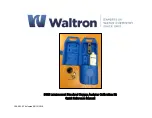
Appendix A. Measurement overview
To measure all three gases, the laser frequency scans across the full spectral range
of interest in about 0.25 seconds (see
below). It uses the reliably fixed
grid spacing in combination with spectroscopic data to determine the exact fre-
quency of each mode. The instrument uses two ring down events—one at the
beginning and one at the end of a scan—to normalize the measured signal.
Absorption is computed at each resonance mode by comparing the normalized
sample photodiode signal with the reference photodiode signal. The concentration
of each gas is then determined by using a fitting algorithm that compares the meas-
ured absorption spectrum with internally stored high resolution spectrum.
Figure A-2. Example of a scan showing the absorption features for a number of gases. The
upper line (dark blue) is the reference signal, and the lower line (green) is the sample sig-
nal at each of cavity resonance modes.
A-2
LI-7820 N₂O/H₂O Gas Analyzer
Summary of Contents for LI-7820
Page 1: ...LI 7820 N2O H2O Trace Gas Analyzer Instruction Manual ...
Page 2: ......
Page 10: ...viii ...
Page 28: ...Section 2 Getting started 2 12 LI 7820 N O H O Gas Analyzer ...
Page 36: ...Section 3 Applications of the LI 7820 3 8 LI 7820 N O H O Gas Analyzer ...
Page 52: ...Section 4 Software overview 4 16 LI 7820 N O H O Gas Analyzer ...
Page 66: ...Section 6 Maintenance 6 8 LI 7820 N O H O Gas Analyzer ...
Page 84: ...Appendix B Additional safety information B 6 LI 7820 N O H O Gas Analyzer ...
Page 91: ......















































